Rhubarb often leaves you scratching your head, right? Is it a fruit or a vegetable? I’m about to set the record straight on rhubarb’s true identity and dive into its fascinating story.
This guide will cover rhubarb’s botanical classification as a vegetable, the USDA’s surprising 1947 fruit label, and how this mix-up influences our kitchen habits. You’ll learn why we love using this tart stalk in sweet dishes and the important safety tip about its leaves. Plus, I’ll explore rhubarb’s growing season and its health benefits, packing a punch with nutrients and antioxidants.
Why should you care? Understanding rhubarb’s dual nature enriches your cooking and highlights this springtime staple’s unique place in our diets. Let’s unravel the mystery of rhubarb together and discover how to enjoy it safely and deliciously.
- Related article: Fruits & Vegetables Differences
5 Key Takeaways on Is Rhubarb a Fruit or Vegetable
- Rhubarb is botanically a vegetable, even though it’s often used in sweet dishes like pies and jams.
- The USDA classified rhubarb as a fruit in 1947 for tax reasons, which adds to the ongoing confusion.
- Rhubarb stalks are safe to eat, but the leaves contain toxic oxalic acid and should be discarded.
- Rich in nutrients, rhubarb offers health benefits like supporting heart health, improving digestion, and promoting bone strength.
- Rhubarb’s tart flavor makes it versatile for both savory and sweet recipes, from chutneys and barbecue sauce to crumbles and jams.
Is Rhubarb a Fruit or a Vegetable?
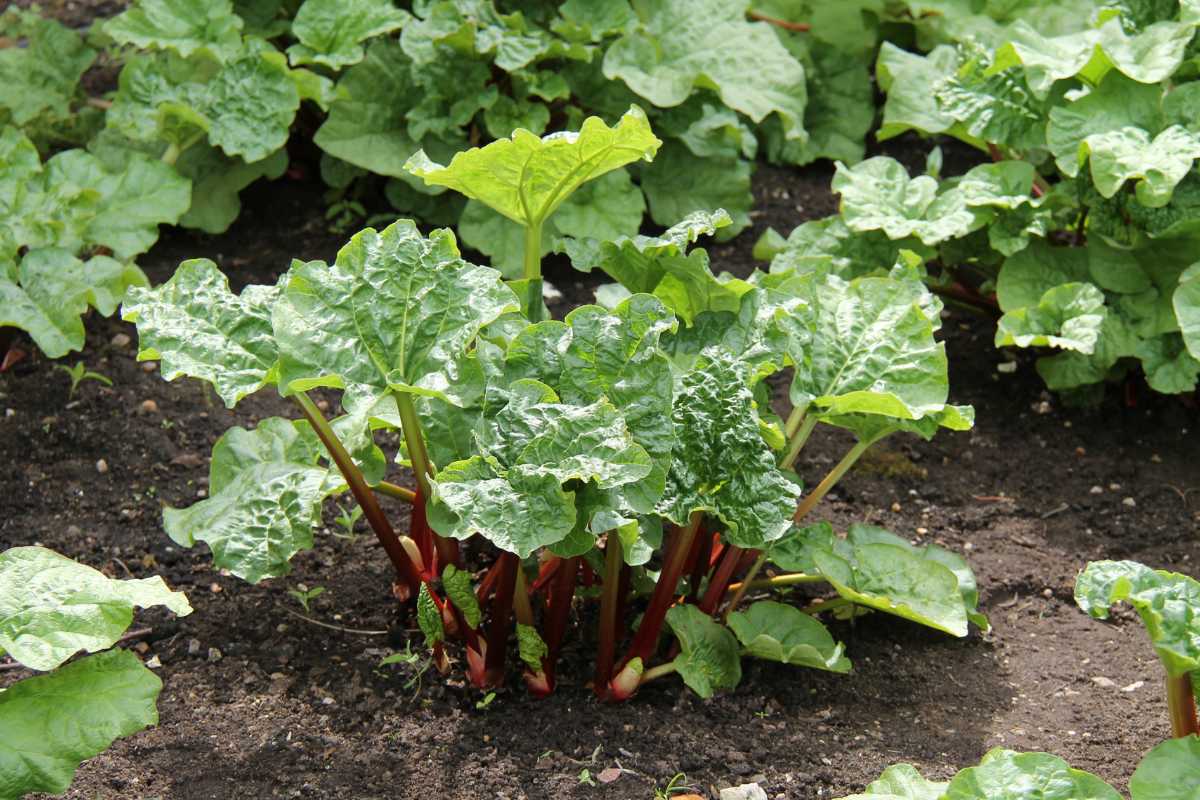
Rhubarb often confuses people. Is it a fruit or a vegetable? Let’s clear this up:
- Botanical Classification – Rhubarb is a vegetable. It belongs to the Polygonaceae family, which includes buckwheat. We eat the stalk, which looks like celery.
- USDA Classification – Back in 1947, the USDA called rhubarb a fruit for tax reasons. Fruits had lower import taxes. This still causes confusion today.
Even though rhubarb is a vegetable, we often use it in sweet dishes like pies and jams. It’s famous for pairing with strawberries, which help cut its sourness. Speaking of sour, rhubarb stalks are tart, much like lemons. That’s why we add a lot of sugar when we cook them.
Now, about safety. Rhubarb stalks are fine to eat, but the leaves are not. They have a lot of oxalic acid, which is toxic. Always throw away the leaves.
Rhubarb grows in cooler climates and is a spring vegetable. It’s usually ready to eat from late March to early June. It’s one of the first plants we can eat in spring.
To sum it up, rhubarb is a vegetable that we often treat like a fruit. This leads to it being called both, depending on who you ask.
Rhubarb Health Benefits
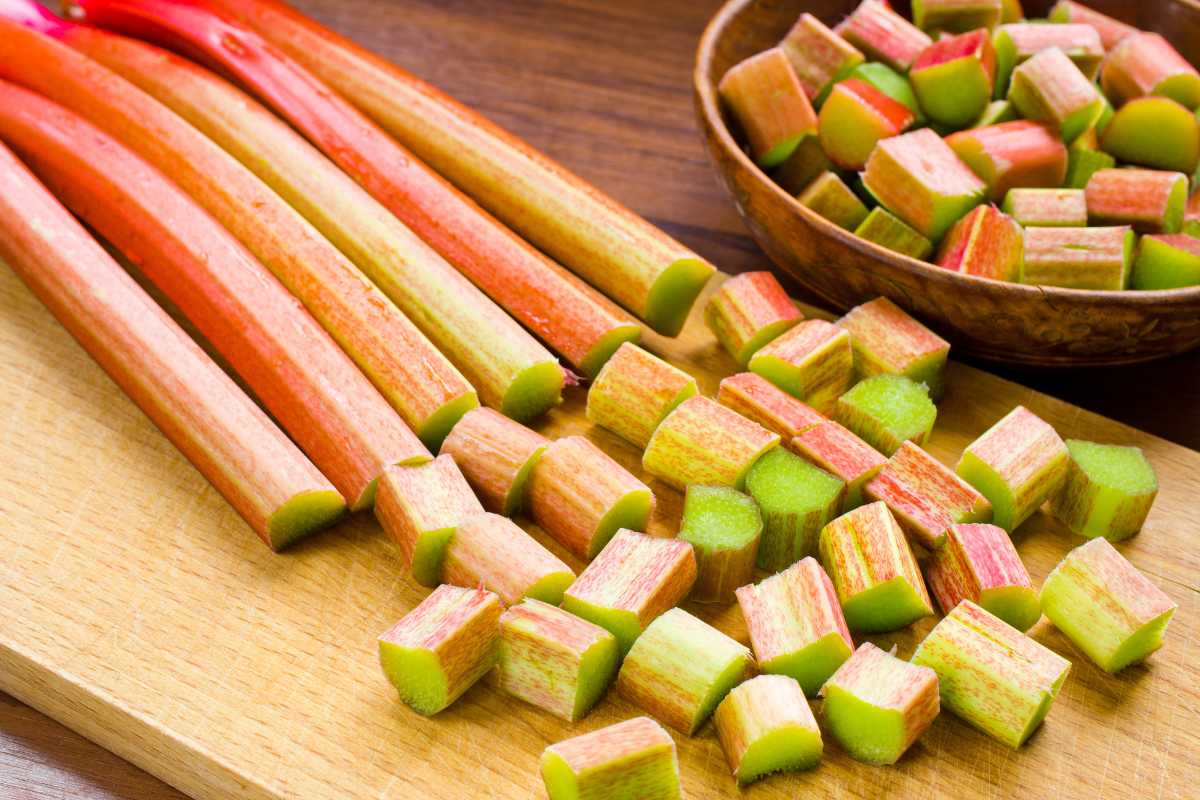
Rhubarb might not be the first thing you think of when it comes to health foods, but it’s a powerhouse of nutrients. Let’s dive into why adding this tangy vegetable to your diet could be a smart move.
- Low-Calorie Vegetable – First off, rhubarb is a friend to your waistline, offering just 15 calories per cup. It’s a treasure trove of fiber, vitamins A and C, calcium, and potassium. With over 40 phytonutrients, it’s safe to say rhubarb is a nutrient-dense food.
- Packed With Antioxidants – Now, onto antioxidants. The red hue of rhubarb comes from anthocyanins, powerful antioxidants that combat free radicals in your body. Eating rhubarb gives you more antioxidants than a cup of kale, which is pretty impressive.
- Supports Heart Health – When it comes to heart health, rhubarb has your back. The fiber helps lower bad cholesterol, while anthocyanins fight inflammation and keep your arteries flexible. Plus, the potassium in rhubarb helps balance out the salt in your diet.
- Good for Bone Health – Rhubarb is also a bone’s best buddy, thanks to its high vitamin K content. This vitamin is important for strong bones and helps your blood clot. People who get enough vitamin K tend to have fewer hip fractures.
- Great for Digestion – If digestion is a concern, rhubarb can help. Its fiber and tannins promote healthy digestion and keep things moving in your intestines.
- May Reduce Inflammation – But that’s not all. Rhubarb might also reduce inflammation, boost liver health, and keep your skin looking youthful.
Rhubarb is a low-calorie, high-nutrient vegetable that offers a slew of health benefits, from protecting your heart to aiding digestion. Adding rhubarb to your meals is a simple way to give your health a boost.
Different Ways to Add Rhubarb to Your Diet
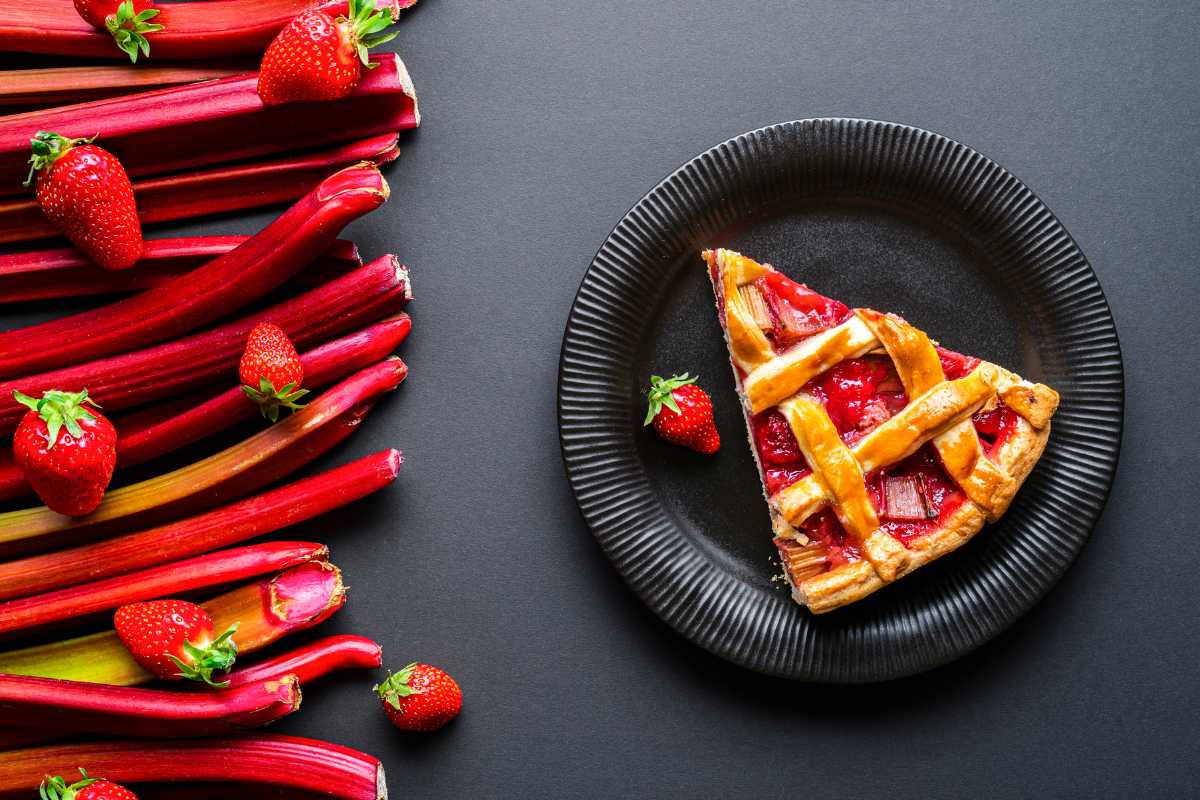
Raw rhubarb tastes quite tart, which is why most folks cook it and add sugar to make it taste more like fruit, especially in popular rhubarb desserts like strawberry-rhubarb pie and rhubarb ice cream.
But if you’re curious, try it raw. It’s milder than when cooked, and you can find fresh rhubarb at farmers’ markets in spring.
Here are some tasty and healthy ways to add rhubarb to my meals:
Savory Dishes:
- Rhubarb Salsa – Blanch rhubarb and mix it with diced strawberries, olive oil, balsamic vinegar, and a bit of sweetener. It’s great with bread, cheese, chips, or pretzels.
- Rhubarb Chutney – Cooking rhubarb with onions, spices, vinegar, and a touch of sweetener makes a zesty sauce perfect for chicken, pork, or fish.
- Rhubarb Barbecue Sauce – Simmer rhubarb with ketchup, vinegar, spices, and sweetener for a unique barbecue twist.
Sweet Dishes:
- Rhubarb Compote – Cooking rhubarb with lemon juice and a small amount of sugar creates a fantastic topping on yogurt, oatmeal, or goat cheese.
- Rhubarb Crumble – This healthy crumble uses rhubarb, oats, nuts, and a bit of sweetener.
- Rhubarb Jam – Cooking rhubarb with sugar and spices gives me a tasty jam for toast, scones, or baked goods. You can also find rhubarb jams available online if you’re looking for a quicker option that saves time compared to making one yourself.
- Rhubarb Fool – A traditional British dessert, this simple dish layers stewed rhubarb with whipped cream for a light, tangy treat.
Drinks:
- Rhubarb Punch – Simmering rhubarb and mixing it with lemon juice and sweetener makes a refreshing drink.
- Rhubarb Orange Refresher – Simmer, strain, and mix rhubarb with orange juice and strawberries for a naturally sweet drink.
Other Ideas:
- Add to Salads – Thinly sliced raw rhubarb adds a nice crunch to green salads or chicken salad.
- Bake into Muffins – Replace some fruit in muffins with chopped rhubarb and add ginger or cinnamon.
- Top Oatmeal – Cooking rhubarb with a bit of sweetener makes a delicious oatmeal topping.
Rhubarb dishes like strawberry-rhubarb pie, rhubarb sauce, and rhubarb ice cream showcase the versatility of this vegetable, blending sweet and tangy flavors.
It’s important to use rhubarb in moderation because it’s high in oxalates. Avoid the leaves and cook the stalks to lower the oxalate levels.
With its unique tart flavor, rhubarb is a delightful addition to both sweet and savory dishes.
However, if you have never tried raw rhubarb, give it a try. It has a milder flavor than cooked rhubarb.You can find fresh rhubarb at farmers markets during springtime.
Rhubarb Storage Tips
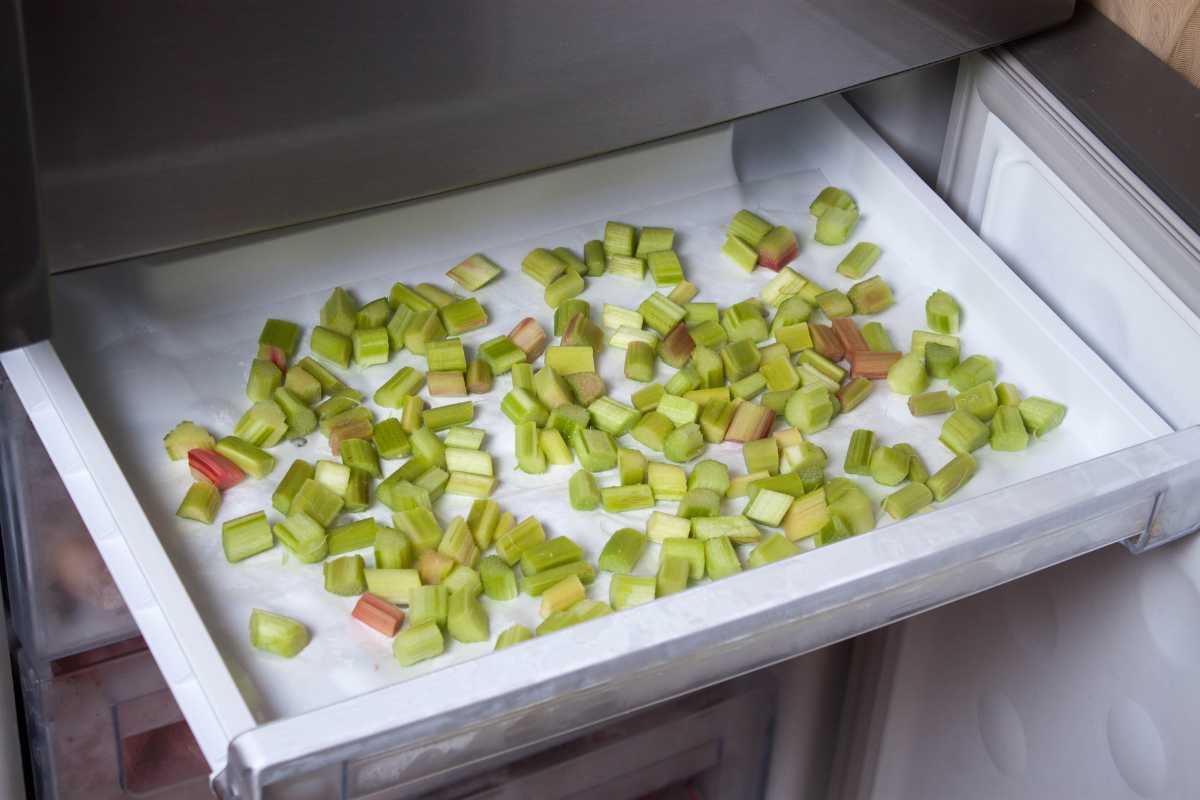
When it comes to storing rhubarb, there are a few tricks to keep it fresh.
- Refrigerate Your Rhubarb – If you want to keep your rhubarb longer, you should refrigerate it. At room temperature, it only lasts a day or two. But if you wrap it and put it in the fridge, it can stay fresh for up to two weeks. For even better results, wrap rhubarb in aluminum foil without sealing the ends.
- Freeze Your Rhubarb – Freezing rhubarb is another option. Just cut the stalks into pieces and lay them on a sheet in the freezer until they are solid. Then, store them in an airtight container or bag. Take out what you need when you need it.
Wondering if your rhubarb has gone bad? Fresh rhubarb has ruby-red stalks. If they turn brown or black, it’s a sign they’ve spoiled. You might also notice a bad smell or mold.
Is Rhubarb a Fruit or Vegetable Final Thoughts
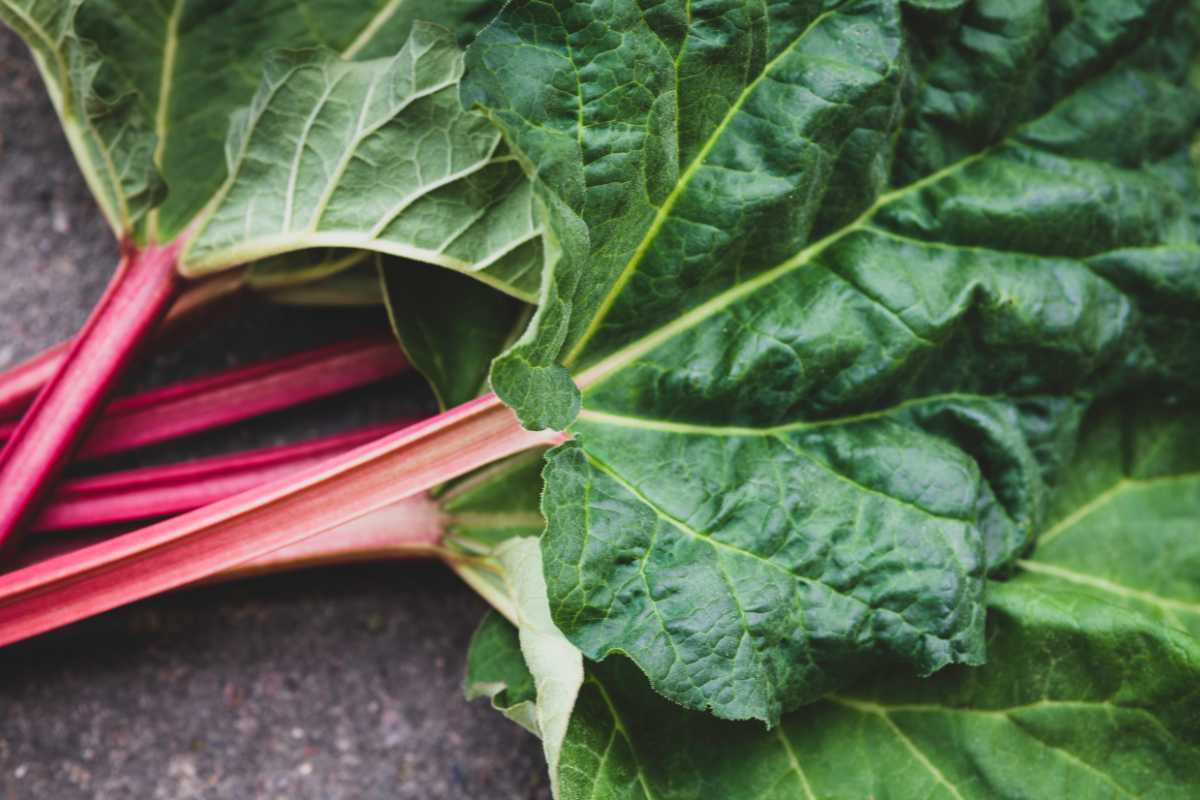
Rhubarb might trip you up because it’s called a vegetable but often ends up in desserts. Its sharp taste works well in sweet recipes, making you wonder about its true identity.
Rhubarb is packed with nutrients and is good for you. It helps keep your heart healthy and aids digestion. You can use rhubarb in all sorts of dishes, from zesty salsas to sweet crumbles, adding a unique touch to your cooking.
Just a heads-up: the leaves are not safe to eat. Stick to the stalks, and you’ll enjoy this springtime treat. It’s a great way to add flavor and health benefits to your meals.
Is Rhubard a Fruit or Vegetable FAQs
1. Can I Freeze Rhubarb?
Yes, it is easily frozen. Cut stalks into pieces and place them on a sheet in the freezer until they turn solid. Place them in an airtight container or bag and remove them as needed.
2. How Will I Know if My Rhubarb Has Gone Bad?
Ruby red stalks are characteristic of fresh, healthy rhubarb. If you notice the rhubarb stalks turning brown or black, it has gone bad and will probably smell. You may also see mold developing.
3. What Does Rhubarb Taste Like?
Raw rhubarb can best be described as tart. For this reason, most people will cook it to use as a fruit and add sugar for taste.
Learn more about other plants and whether they’re fruit or vegetables in the following articles:


